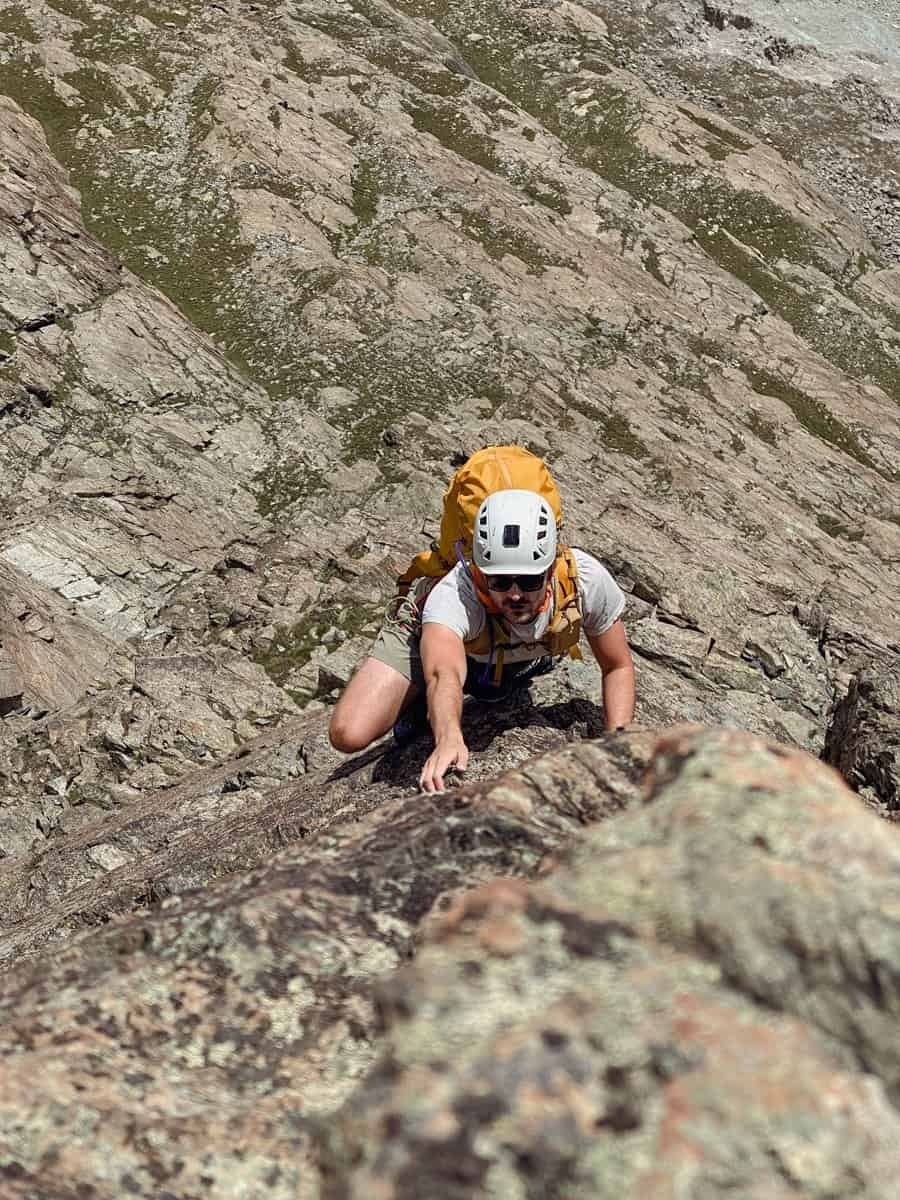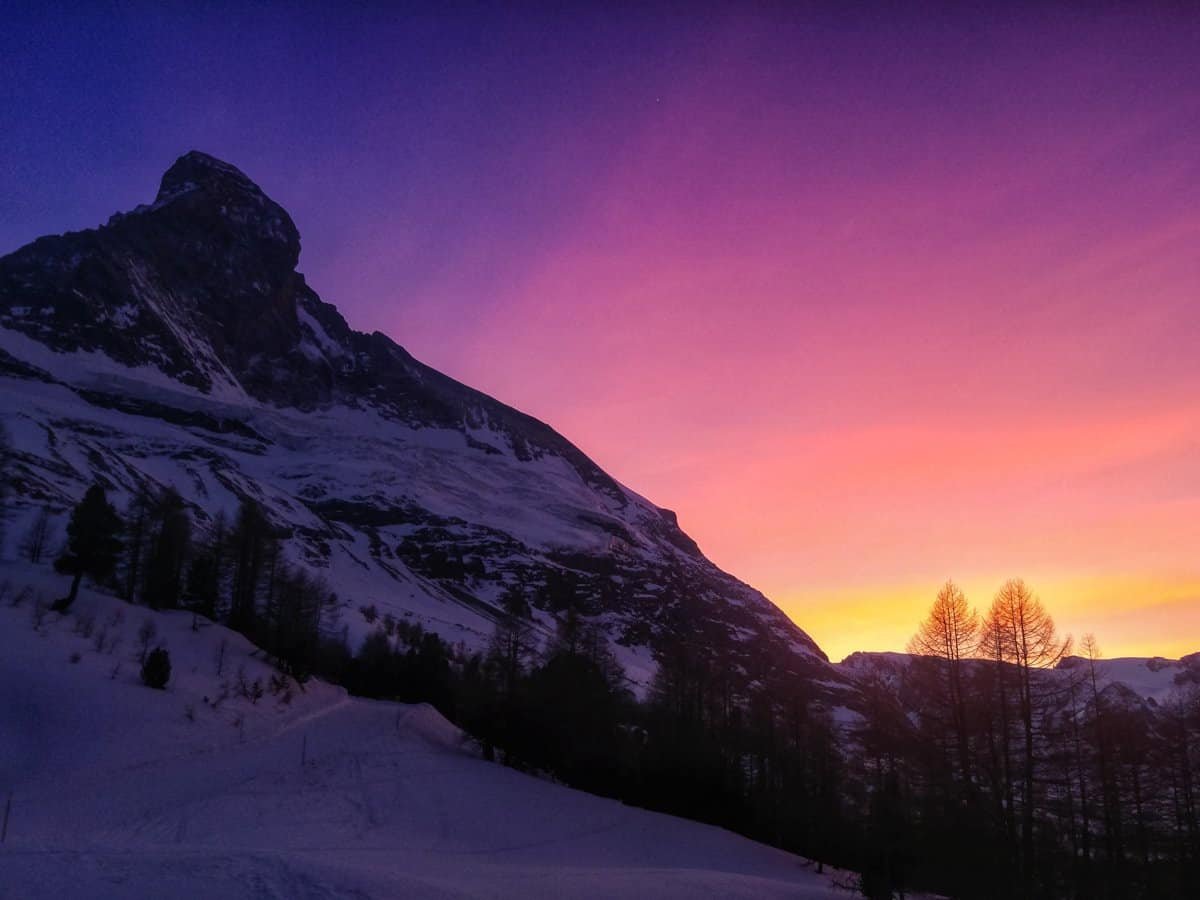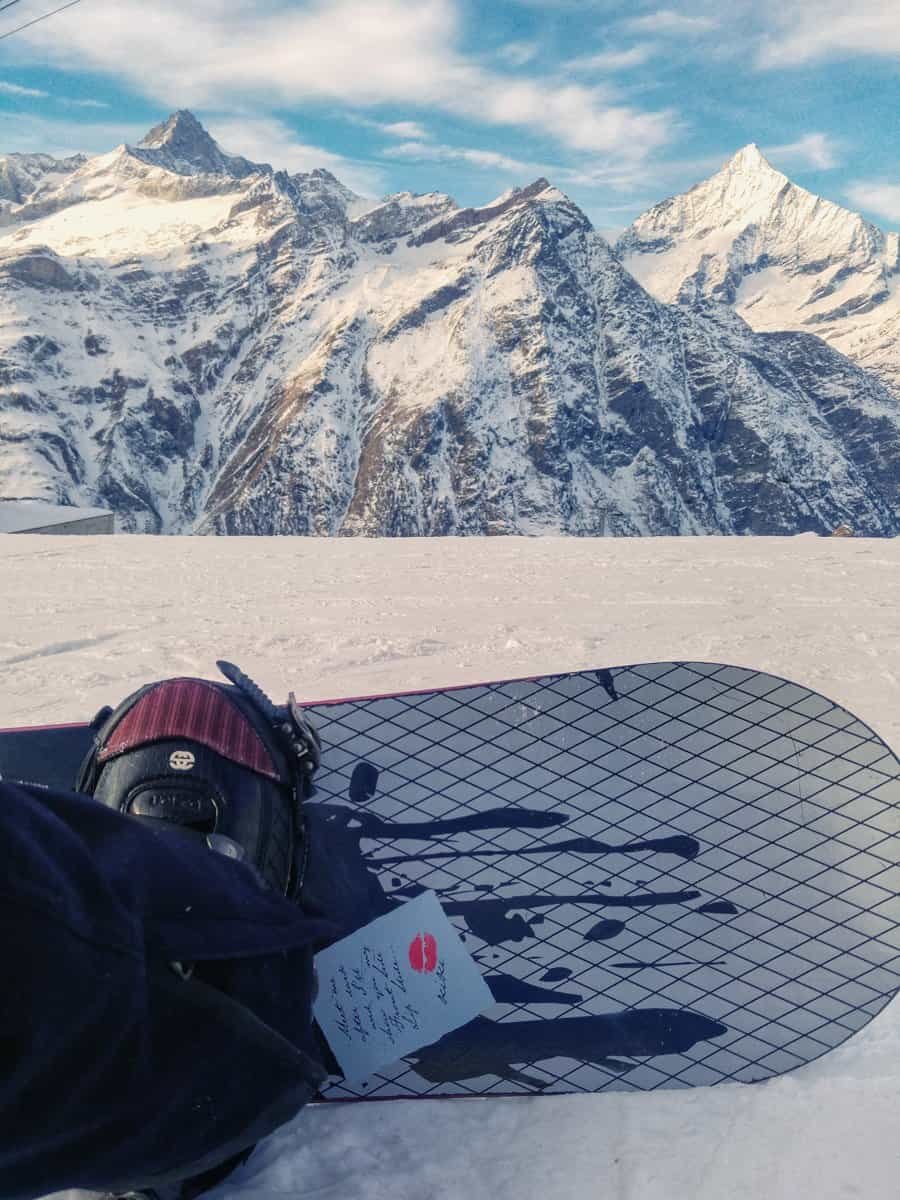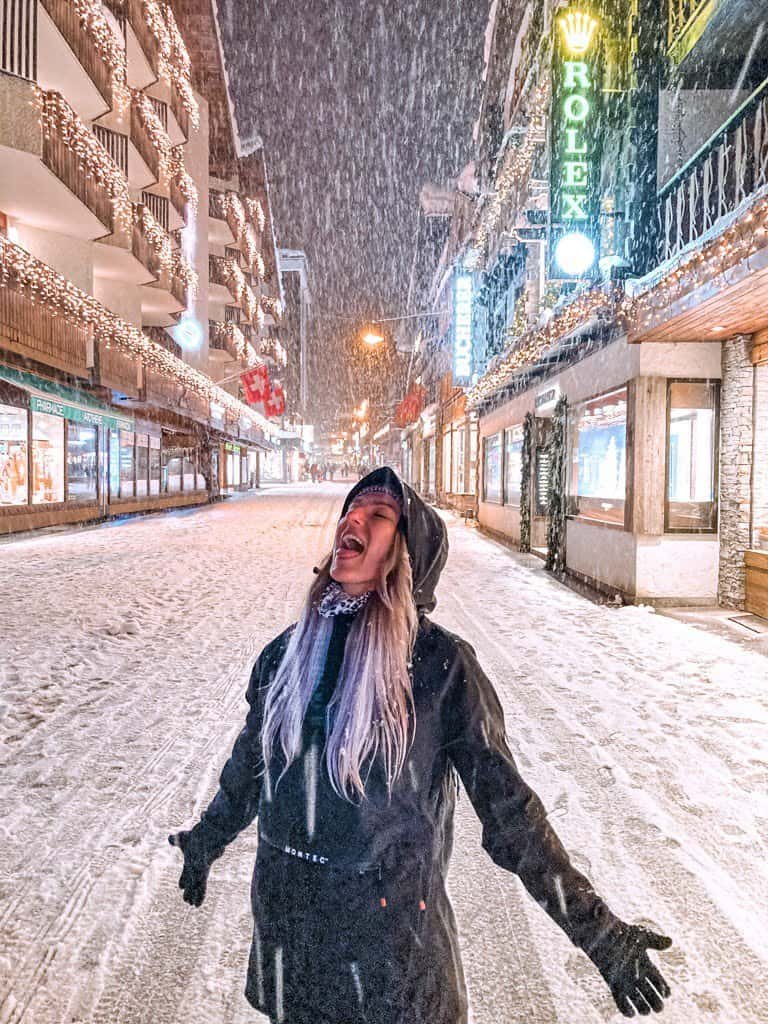The Best Time to Visit Zermatt | 2025 Travel Guide
Whether you’re dreaming of powdery slopes, blooming alpine meadows, or cosy evenings under fairy lights, picking the perfect time to visit Zermatt is part of the adventure!
Zermatt is a year-round playground that draws adventurers and dreamers alike. Whether you’re carving the slopes in winter or hiking lush trails beneath the summer sun, this enchanting village offers a little something for everyone.
But when is the best time to visit? Join us as we explore the allure of Zermatt across the seasons, weighing the perks and quirks of each, to help you decide when to experience this alpine wonderland at its finest.

Realistically, there is no best time to visit Zermatt, only the best time for you, and this may also mean multiple visits. Zermatt really is a four-season destination.
Ok, so I might be a little obsessed over here, so take a look and decide for yourself.
Key Takeaways
✦ Spring is for the bluebird skiers, music lovers and crowd avoiders.
✦ Summer is for the hikers, bikers, climbers and sunbathers.
✦ Autumn is for quiet loving, crisp air adventurers and golden foliage adorers.
✦ Winter is for snowsports enthusiasts and winter wonderland travellers.
Discover Zermatt contains affiliate links, if you make a purchase using one of these links, we may receive compensation at no extra cost to you. Read our disclaimer for more information.
A Guide to Temperature Differences in Zermatt
Where we mention average temperatures for each season, bare in mind that this is the average temperatures for Zermatt Town.
The Glacier Palace in Zermatt is located inside the Matterhorn Glacier Paradise, at an altitude of around 3,883 m (12,739 ft). In contrast, Zermatt town sits at about 1,620 m (5,315 ft).
That’s a vertical difference of over 2,200 m, which has a significant impact on temperature and the weather in general.
General Temperature Rule for Elevation
On average, temperature drops about 6.5°C for every 1,000 m gained in altitude. So between Zermatt and the Glacier Palace, you can expect an average temperature difference of 13–15°C.
Seasonal Differences (Approximate Averages)
| Season | Zermatt Town Avg. | Glacier Palace Avg. | Difference |
|---|---|---|---|
| Winter (Dec–Feb) | -5°C to 2°C | -18°C to -10°C | ~13–16°C |
| Spring (Mar–May) | 2°C to 10°C | -12°C to -5°C | ~12–15°C |
| Summer (Jun–Aug) | 10°C to 20°C | -5°C to 0°C | ~13–20°C |
| Autumn (Sep–Nov) | 5°C to 12°C | -10°C to -3°C | ~12–15°C |
Notes & Tips
Wind chill can make the glacier area feel even colder—especially in winter and early spring. The Glacier Palace stays below freezing year-round, even in summer.
This means that no matter what time of year you visit Zermatt, bring a layering system to keep you comfortable at different altitudes.
Start your day by checking the weather forecast for Zermatt and the areas of the mountain you plan to visit i.e. Trockener Steg, Klein Matterhorn etc. The best apps for Zermatt weather are MeteoSwiss and yr.no.
Best Time to Visit Zermatt by Season
Zermatt’s one of those places that’s magic no matter when you go. Seriously, every season brings its own kind of awesome.
Spring is the chill season. The snow starts melting, and all these lush green meadows and wildflowers pop up, making it perfect for quiet hikes and just taking it easy.
Summer rolls in, and it’s all systems go for the adventure crowd. Sun’s out, trails are calling—whether you’re on foot or a bike—and there’s always some festival or event going on to keep things buzzing.
Autumn is underrated, if you ask me. The place turns into this postcard-worthy scene with golden trees and crisp air. Plus, it’s quieter, which makes it a dream for taking photos or just soaking it all in without the crowds.
Winter is the big-time showstopper. Zermatt turns into a proper snow globe, with skiing, snowboarding, and all that alpine magic.
It doesn’t matter if you’re into high-octane adventures, laid-back nature vibes, or a bit of both—Zermatt just gets it right, every single time.
Spring
Spring is a great time to visit Zermatt because it combines three key activities that Zermatt is renowned for –skiing, hiking and live music. With fewer crowds, you can enjoy the slopes with more space, less waiting time and warmer temperatures.
The main ski area stays open until late April or early May, while the glacial ski area remains open 365 days per year.

In late spring, as the snow melts and more trails open, the milder weather makes it an ideal season for hiking, allowing you to explore comfortably without the crowds. But note that many trails higher up, won’t be clear of snow until the height of summer.
If you’re into music, April in Zermatt is an absolute treat. Zermatt Unplugged is a one-of-a-kind music festival. Known for its emphasis on acoustic music, it features a diverse lineup of international and local artists.
The whole thing is set against the jaw-dropping Swiss Alps. You can listen to live music while the mountains stand there, all majestic and snowy in the background. It’s got this really chilled, intimate vibe that’s hard to find at bigger festivals.
This blend of activities, alongside the pleasant climate, makes spring an ideal time for a versatile visit to Zermatt. It’s a laid-back, do-whatever-you-fancy kind of season.
When | March to May
Temperature | In March, average temperatures range from -3°C to 5°C (27°F to 41°F). By April, temperatures typically rise to between 0°C and 9°C (32°F to 48°F). In May, you can expect averages from 4°C to 14°C (39°F to 57°F).
Keep in mind that temperatures can vary, especially with changes in altitude.
Precipitation | March typically receives around 60 mm (2.4 inches) of precipitation. In April, this increases to about 70 mm (2.8 inches). By May, the average precipitation rises further to approximately 80 mm (3.1 inches).
These figures can fluctuate, but they give a general idea of what to expect during the spring months. The precipitation mix of snow and rain varies as temperatures rise.
In March, a significant portion of precipitation can still fall as snow, often around 60-70%, due to colder temperatures. By April, this percentage decreases, with snow accounting for about 40-50% as temperatures warm. In May, snow becomes less common, with rain making up the majority of precipitation, and snow accounting for roughly 20-30%.
These percentages can fluctuate based on specific weather conditions each year.
Activities | Skiing, Snowboarding, Ski Touring, Splitboarding, Sledging, Snowshoeing, Paragliding, Husky Sleigh Rides, Hiking, Rock Climbing, Gornergrat Railway, Matterhorn Paradise, Alpine Crossing, Helicopter Tours, Guided Walks, Spa Experiences and Shopping.
Events | Zermatt Unplugged, usually held in April, this renowned acoustic music festival attracts artists and music lovers from around the world. Set against the stunning alpine backdrop, it features intimate performances at various venues, providing a unique blend of music and mountain ambience.
Patrouille des Glaciers, held once every two years in April, is an epic ski mountaineering race that spans from Zermatt to Verbier. This challenging event draws elite athletes and adventurous spirits, showcasing incredible endurance and skill.


Crowds | In spring, Zermatt experiences moderate crowd levels compared to the busy winter ski season. The village sees a mix of visitors, including those interested in late-season skiing and early hikers. Key events such as Zermatt Unplugged and Patrouille des Glaciers increase tourist numbers.
Overall, the spring crowds allow for a more relaxed visit than the peak winter months.
Prices | During the spring season, prices in Zermatt are generally more moderate compared to the peak winter months. A ski pass is at its lowest price in April. Dining prices remain relatively stable year-round.
Accommodation costs tend to decrease after the high-demand winter skiing period, providing more affordable options for visitors. Prices may be more expensive over the peak weeks of Easter and Zermatt Unplugged.
Compared to summer, spring offers a mix of winter and off-peak pricing. Making it a balanced time for both budget and experience.
Tips | Spring in Zermatt is a season of transition, so packing smart is key. Layering is your best friend here, as the weather can shift from chilly mornings to sunny afternoons. A waterproof jacket is a must, considering the occasional spring showers.
For activities, seize the chance to enjoy both the tail end of skiing and the onset of hiking season. While many slopes remain open into April, the trails start to reveal themselves as the snow melts, perfect for lower altitude early hiking adventures.
To help plan your spring visit to Zermatt, here’s our in-depth guide to activities, accommodation, and hidden gems:
Summer
Summer in Zermatt is an absolute dream for anyone who loves a bit of nature and adventure. You’ll have your phone out every five seconds snapping the views (or just gawking at them, honestly).
When the snow clears off, the mountains turn into a lush, green playground. Perfect for hiking and mountain biking. Whether you’re a trail noob or a seasoned adventurer, there’s a route with your name on it.

The weather’s just right for exploring, warm, sunny days that practically beg you to be outdoors, and cool evenings for kicking back with a hot drink in the village. Layer up, though—mountain weather is as moody as your neighbour’s cat, and it can flip in no time.
Zermatt also knows how to throw a good party (or a marathon, in this case). There’s the Folklore Festival in August—traditional Swiss music, dancing, and all the lederhosen you could want. The Gornergrat Zermatt Marathon in July is a beast of a race winding up the mountains.
If festivals aren’t your thing, take a ride on the Gornergrat railway and picnic by those gorgeous mountain lakes. Take a dip if you’re a brave cold-water swimmer, or get your adrenaline going with a spot of paragliding or summer glacier skiing.
When | June to August
Temperature | During the summer months in Zermatt, the average daytime temperatures range from 15°C to 25°C (59°F to 77°F), providing pleasant conditions for outdoor activities. At night, temperatures can drop to between 5°C and 10°C (41°F to 50°F).
Due to Zermatt’s high altitude, the weather can change quickly, and temperatures can vary significantly, especially when moving to higher elevations. This variation makes it important to be prepared for warm sunny days and cooler, breezy conditions.
Precipitation | The summer months in Zermatt, typically see moderate precipitation levels. June, July, and August experience an average of about 50 to 70 mm of rainfall per month. Rainfall is generally sporadic, with short, intense showers more common than prolonged rain spells.
One of my favourite things about this time of year is the occasional thunderstorms. There’s nothing quite as dramatic as lightning striking behind the Matterhorn.
This means you might encounter brief rain during your adventures, but it’s often interspersed with plenty of dry, sunny periods. The high-altitude can lead to quick weather changes, have your rain gear on hand just in case those clouds roll in.
Activities | Hiking, Mountain Biking, Summer Glacier Skiing & Snowboarding, Rock Climbing, Paragliding, Kickbikes & Scooters, Gornergrat Railway, Matterhorn Paradise, Alpine Crossing, Helicopter Tours, Golf, Wakeboarding/Waterskiing and Tennis.


Events | The Gornergrat Zermatt Marathon takes place in July, starting in St. Niklaus (1,116m) and finishing at Riffelberg (2,582 m).
It’s not just for the pros either. You’ll find a mix of elite runners and weekend warriors all giving it a crack. If you’re going to torture your legs, you might as well do it among some of the most jaw-dropping scenery in the world.
Swiss National Day is celebrated annually on August 1st, marking the founding of the Swiss Confederation in 1291. This public holiday is recognised nationwide with fireworks, parades, markets and public speeches.
The Folklore Festival in Zermatt, held in August, celebrates Swiss traditions through a vibrant showcase of cultural heritage. The event features traditional music, dance, and costumes, offering a rich display of Swiss folklore.
It serves as a platform to promote and preserve cultural heritage, attracting visitors eager to experience Switzerland’s authentic and diverse traditions.
Matterhorn Ultraks is where trail running meets epic views—and it all kicks off in late August. They’ve got a bunch of courses to choose from. So whether you’re chasing a personal best or just hoping to survive (no shame, we’ve all been there), you’ll be running through some of the most stunning trails around Zermatt’s peaks.
It’s not just for the hardcore ultra-running crowd, either. Amateurs are welcome, and they even have races for the kids.
Crowds | In summer, Zermatt is bustling with tourists eager for hiking and climbing adventures, especially during events like the Matterhorn Ultraks. The lively summer atmosphere rivals early spring activity levels, but not the peak months of winter.
Prices | Summer accommodation prices tend to be lower than winter months and closer to early spring prices, but not quite the lows of late spring.
Tips | Summer in Zermatt is all about embracing the great outdoors, so packing the right gear is essential. Think layers and sun protection; the mountain sun can be intense, but temperatures can drop as you climb higher. A hat and sunscreen are your best pals here.
Dive into summer activities like hiking the scenic trails or catching the Matterhorn Ultraks, a must-see event for any adventurer.
The vibrant atmosphere is contagious, and the long days mean more time to explore. Whether it’s trekking to a mountain peak or strolling through the lively village streets, make sure to soak in the stunning views and vibrant culture that Zermatt offers in this sun-kissed season.
To help plan your summer visit to Zermatt, here’s our in-depth guide to activities, accommodation, where to eat and hidden gems:
Is Zermatt Worth Visiting in September?
Zermatt is worth visiting in September. The crowds have thinned out, so you get to enjoy the Swiss Alps in a much calmer, more laid-back way.
The weather is spot on, with that perfect blend of late summer warmth and a hint of autumn crispness in the air—ideal for getting outdoors and making the most of it.
The hiking trails are spectacular, offering a mix of summer greens and the first bursts of golden autumn tones. It’s a quieter, more intimate way to explore, with stunning views wherever you look.
Whether you’re hiking the trails or enjoying the views, September’s tranquillity and beauty make it a perfect time to visit.
Autumn
Autumn in Zermatt is pure magic. With summer’s buzz fading away, the town slows down, offering a kind of stillness that’s rare and refreshing. The air is crisp, that perfect kind of cool, and the mountains are draped in stunning golden shades.

For hikers, this is as good as it gets. The trails are quiet, the views are jaw-dropping, and every moment feels like it’s meant just for you. Adding to the appeal, the Zermatt Music Festival rolls through, blending alpine beauty with cultural elegance.
Whether you’re strolling past chalets or capturing autumn’s fiery leaves, Zermatt in fall is peaceful, beautiful, and unforgettable.
When | September to November
Temperature | In Zermatt, autumn temperatures vary as the season progresses. In September, you can expect average highs around 54°F (12°C) and lows of 37°F (3°C). By October, temperatures drop to highs of 46°F (8°C) and lows of 31°F (-1°C). In November, it gets colder, with highs around 35°F (1°C) and lows of 21°F (-6°C).
Precipitation | In Zermatt, autumn sees a rise in precipitation. In October, the area typically receives about 186 mm of rain over approximately 10 rainy days. September and November also experience similar patterns, with varying amounts of rainfall as the season progresses. It’s a good idea to be prepared for wet weather during your autumn visit!
Snowfall can begin as early as October. By November, snow becomes more common. The transition from rain to snow typically occurs as temperatures drop, especially at higher altitudes.
Activities | Hiking, Mountain Biking, Summer Glacier Skiing & Snowboarding, Rock Climbing, Paragliding, Kickbikes & Scooters, Gornergrat Railway, Matterhorn Paradise, Alpine Crossing, Helicopter Tours, Golf, Wakeboarding/Waterskiing and Tennis.


Events | Zermatt Music Festival is a celebration of classical music that transforms the crisp September air with its enchanting performances. Renowned artists and ensembles fill the intimate venues with melodies that resonate beautifully against the alpine backdrop.
Crowds | In autumn, Zermatt sees a moderate reduction in tourist crowds compared to the summer and winter seasons. The town is less crowded, offering a more relaxed atmosphere.
The Zermatt Music Festival draws some visitors, but accommodations are generally more available and often cheaper. It’s a quieter period, ideal for those seeking a more peaceful experience.
Prices | In autumn, Zermatt experiences fewer visitors, resulting in more available rooms and often lower rates. This makes it an ideal time for budget-conscious travellers who prefer a quieter, more relaxed atmosphere.
Tips | The weather can be a bit of a mixed bag with chilly mornings and warmer afternoons, so think cosy sweaters, a good jacket, and maybe a scarf for those brisk alpine breezes. Waterproof footwear is a must for those scenic hikes through the vibrant fall foliage.
While you’re there, don’t miss the Zermatt Music Festival if you’re visiting in September. The tunes add a fantastic cultural touch to your trip. For outdoor lovers, the hiking trails are less crowded, offering stunning views without the hustle and bustle—perfect for those Instagram-worthy shots.
Many activities and some businesses close in late October as Zermatt transitions into its winter season. Be sure to check your desired itinerary before making any bookings.
To help plan your autumn visit to Zermatt, here’s our in-depth guide to activities, accommodation, where to eat and hidden gems:
Winter
Winter in Zermatt is a snowy paradise for thrill-seekers and nature lovers alike. You’ll find world-class skiing and snowboarding on slopes that range from beginner-friendly blues to expert yellows.

If you’re after tranquillity, snowshoe through serene winter trails or ride the Gornergrat Railway for awe-inspiring views. And, don’t miss those dramatic winter sunsets.
The town bursts with festive cheer from December 1st after the Christmas Tree Lighting and keeps the holiday spirit alive until spring.
When | December to February
Temperature | The average temperatures in Zermatt can vary slightly from December to February. Generally, December might be a bit milder as winter sets in, with temperatures often ranging from -5°C to 2°C (23°F to 36°F).
January is typically the coldest month, with averages from -10°C to 0°C (14°F to 32°F). By February, temperatures start to rise slightly, ranging from -8°C to 2°C (18°F to 36°F).
Precipitation | During the winter months in Zermatt, precipitation primarily falls as snow, creating the perfect conditions for winter sports and scenic landscapes. On average, Zermatt receives about 50 to 70 mm of precipitation per month from December to February.
Snowfall has become unpredictable in recent years, so check the forecast for the most accurate conditions.
Activities | Skiing, Snowboarding, Ski Touring, Splitboarding, Ice Climbing, Sledging, Snowshoeing, Paragliding, Husky Sleigh Rides, Winter Hiking, Gornergrat Railway, Matterhorn Paradise, Alpine Crossing, Helicopter Tours, Guided Walks, Spa Experiences and Shopping.


Events | The Christmas Tree Lighting in Zermatt is a cherished annual event that typically takes place at the beginning of December in the heart of the village.
As the festive season kicks off, locals and visitors gather around the beautifully adorned tree in the town square, where the twinkling lights bring a warm glow to the snowy surroundings.
The Horu Trophy in Zermatt is an annual curling tournament that takes place in January, attracting teams from all over Europe. The Horu Trophy is a must-see winter spectacle for curling fans and curious visitors.
Crowds | During winter, Zermatt buzzes with activity, especially around the festive season and weekends, drawing in a lively mix of ski enthusiasts and holidaymakers. The peak times are Christmas, New Year, and the last three weeks of February.
For those looking to dodge the busiest periods, visiting during weekdays or avoiding school holidays can offer a more relaxed experience.
Prices | In winter, Zermatt is known for being a premium destination, with prices reflecting its popularity and exclusivity. Accommodation rates can be quite high, especially during peak times like Christmas and New Year, with luxury hotels and chalets commanding top prices.
Tips | Book accommodations early, especially during the holidays, to secure the best deals.
Pack quality thermal layers to stay warm without bulking up—essential when the alpine winds pick up. Also, bring a pair of sturdy, waterproof boots; they’re vital for navigating snowy streets and trails comfortably.
A portable phone charger is a lifesaver, especially when capturing those stunning mountain views, the cold drains your battery faster than you expect. Lastly, consider packing a small backpack to carry your camera, snacks, and any extra layers you might need.
Is Zermatt Better in Summer or Winter?
Zermatt offers unique experiences in both summer and winter, making it a fantastic destination year-round. In winter, it’s a haven for skiing and snowboarding enthusiasts, with its world-class slopes and stunning snowy landscapes.
The winter season also brings a cosy, festive atmosphere, perfect for enjoying après-ski activities and alpine dining.
In summer, Zermatt transforms into a paradise for hikers and nature lovers. The trails offer breathtaking views of the Matterhorn and surrounding peaks, and the weather is ideal for outdoor adventures. Summer also allows for activities like mountain biking and climbing.
Ultimately, whether Zermatt is better in summer or winter depends on your personal preferences and the type of activities you enjoy.
If you’re a fan of winter sports and snowy scenery, winter is your season. If you prefer hiking and exploring nature in milder weather, summer might be more appealing.
To help plan your winter visit to Zermatt, here’s our in-depth guide to activities, accommodation, where to eat and hidden gems:


How Many Days do I Need in Zermatt?
To fully soak in the magic of Zermatt, plan for at least three to five days, depending on your interests. If skiing is your main draw, you’ll want a few days to tackle the extensive slopes and enjoy some downtime at the cosy après-ski spots.
For hiking enthusiasts visiting in summer, the trails offer endless exploration opportunities, with iconic paths like the Five Lakes Walk providing unforgettable views of the Matterhorn.
Culture buffs should set aside time to wander through the charming village, visit the Matterhorn Museum, and indulge in local Swiss cuisine, including must-try dishes like fondue and raclette.
No matter the season, a ride up to the Gornergrat for panoramic views is an absolute must. With a mix of activities and leisure, you’ll find three to five days gives you a perfect taste of what this alpine paradise has to offer, with enough flexibility to relax and explore at your own pace.
For a deeper dive, check out our guide here:
How Many Days in Zermatt? 1 to 4 Days Itinerary Planning
Final Thoughts on the Best Time to Visit Zermatt
Zermatt really knows how to show off, no matter the time of year. Winter’s all about carving across powdery slopes with the Matterhorn towering in the background. Summer swaps out the snow for sun-soaked trails and lively festivals—it’s like the whole place bursts into colour.
Spring and Autumn are absolute gold for anyone after a bit of peace—think quiet paths, crisp air, and landscapes that pretty much beg to be admired.
Honestly, whenever you visit, Zermatt lays it all out—adventure, stunning views, and a natural beauty that sticks with you long after you leave. Time to pack your bags, don’t you think?